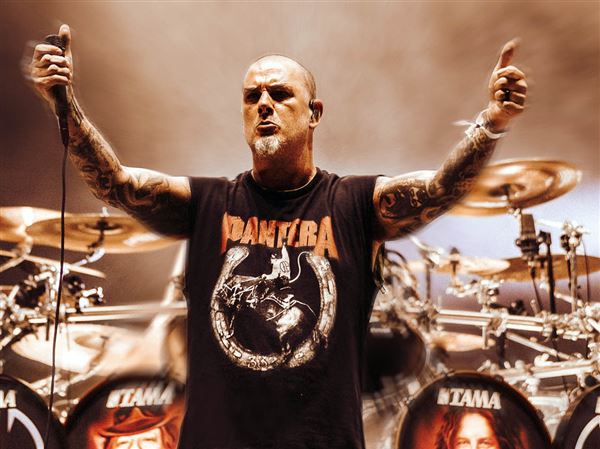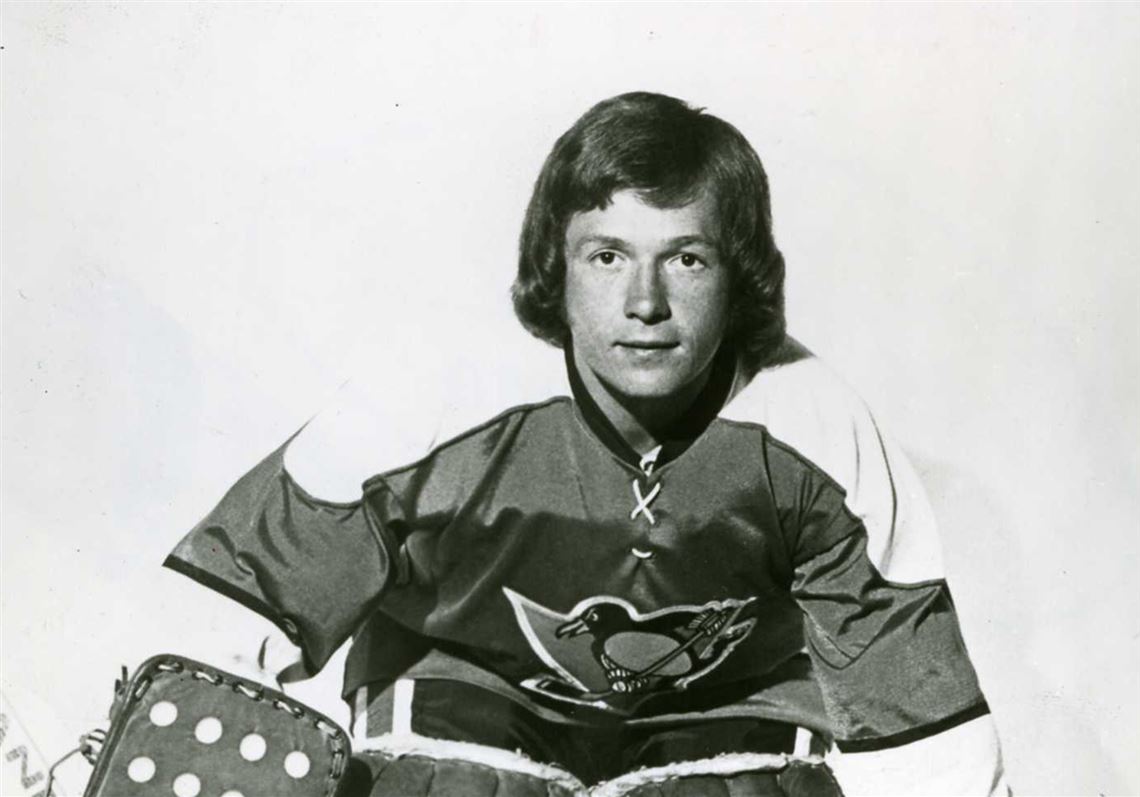In hindsight, Hank Bassen was hardly dressed for success when he stepped into the home net at the old Civic Arena for the first game in Penguins history.
Bassen donned no mask, exposing a crewcut, his cleft chin and an eager grin. His brown leather leg pads weighed around 15 pounds apiece and would grow even heavier as the deer hair inside soaked up water and sweat. The two-piece chest protector tucked under his blue jersey was just stuffed canvas and felt.
Standing in that primitive gear, the 5-foot-10 goalie filled a third of the net.
Known in his day for his excursions from his crease and the daring way he sometimes dropped to his knees or dove at the puck, Bassen still made 37 saves that night as the expansion Penguins fell 2-1 to the mighty Montreal Canadiens.
Fifty-five years later, a goaltender’s primary job function remains unchanged — put yourself between a frozen piece of rubber and the 6-by-4 net frame. But the tools and tactics utilized by today’s puck-stoppers are so advanced they can make it look as if they are playing a completely different position than Bassen.
“There’s not a position in the world of professional major sports — not quarterback, not pitching, not anything — that has evolved like goaltending,” said Kevin Weekes, the ESPN analyst who previously prowled NHL creases for 11 years.
Innovations in goalie equipment and changes to the way the position is played are intertwined, much like a skate lace twisting around itself and tightening.
Without Jacques Plante and his mask, there is no butterfly revolution ushered in by Patrick Roy. Garth Snow and his supersized setup begat a controversial rule change with unintended benefits. New developments with leg pads and skates have Andrei Vasilevskiy and Igor Shesterkin shuffling the position to new heights.
“The protection ultimately changed the way the position was played,” said InGoal Magazine editor Kevin Woodley, who moonlights as a beer-league goalie.
How exactly did that happen? And what will the future hold for the position?
With insights from NHL goaltenders past and present — a group whose collective experience spans seven decades and counting — we trace the path of its evolution. The big-bang moment was a rising Andy Bathgate shot back in 1959.
Masked men arrive
Clint Benedict was the first goalie to use a mask, wearing one in 1930 after a shot shattered his cheekbone. It obstructed his view, so he soon ditched it. It wouldn’t be until after Plante came along that masks became commonplace.
As legend has it, the Canadiens great commissioned the design of a thin fiberglass mask that was fitted to his face but he only donned it during practice. That changed when Bathgate, who would later play for the Penguins, sent Plante to the dressing room with a puck to the face. Plante emerged wearing his mask.
The Canadiens won, so Plante stuck with the mask despite skepticism from some coaches, including his own, Toe Blake. The goalie went on to win the Vezina Trophy four more times, validating his decision. His success, along with booming slap shots becoming all the rage in the 1960s, pushed his peers to follow suit.
Jim Rutherford didn’t wear a mask while rising the youth hockey ranks in Ontario.
“I didn’t think anything of it,” he said. “That’s just the way it was in those days.”
He was 16 when he first pulled one on at a junior camp in Toronto in 1965.
Thirty seconds later, he was missing four teeth and in need of 42 stitches.
“A guy came to the hash mark and took a slap shot. Hit me right in the mouth with the mask on. That was my first experience with a mask,” he chuckled. “But, as my mother pointed out, it would have been a lot worse if I didn’t have it.”
As Rutherford put it, those early masks made goalies feel safer but not exactly safe. Tight to your face with very little cushion, a mask was mostly there to prevent nasty gashes. “You still got the full blow where that puck hit you,” he said.
More modern goalies are still in awe of how their predecessors were wired.
Penguins goalie coach Andy Chiodo started his career with the New York Islanders before playing for the Penguins in 2003-04. After the Islanders drafted Chiodo, they sent Hall of Fame goalie Billy Smith up to Toronto to work with him.
Smith, then in his 50s, wanted to make a point to Chiodo about the placement of his hands. “Give me your gloves and stick,” Smith said. Smith then jumped in net in just a sweat suit and had players wire shots at him from the blue line.
“I’ll never forget it. It was almost like he came to life. He steps in there fearlessly and got dialed in,” Chiodo said. “The players couldn’t believe what he asked them to do. In that moment, I had a reminder of just what these guys did and how special that was and how much passion they must have had to do that.”
In 1977, NHLer Dave Dryden and Toronto mask designer Greg Harrison developed the first mask-cage combo. The wire bars covering the face and nose helped deflect the impact of shots. It also improved visibility and airflow for goalies.
That mask was the forefather to the “birdcage” helmets that were popular in the 1980s and today’s modern masks, made with carbon fiber and Kevlar.
The first mask was the greatest innovation in the history of the position, Woodley argued. But as the 1980s arrived, the shooters held the advantage.
The butterfly effect
Goalie gear was improving but not yet gargantuan. At that point, specialized goalie coaches were nonexistent, forcing budding goalies such as Ron Hextall to watch the pros and figure out the position for themselves. Practicing yoga and Pilates, training methods used by many current NHLers, would get you laughed at.
Young supernova Wayne Gretzky and other star scorers took over in the early 1980s, with the league’s goals-against average spiking to an all-time high of 3.95 during the 1981-82 season. Shooters often overpowered stand-up goalies, crossing the blue line and blasting slap shots past their outstretched skate blades.
Enter a Quebec native and former college goalie named Francois Allaire.
Allaire did not invent the butterfly technique, in which a goalie drops to his or her knees in the shape of a V to try to seal the bottom of the net. Goalies such as Glenn Hall and Tony Esposito deployed a variation of it in the 1960s and 70s.
But he believed it could be the foundation of a goalie’s play, especially with better masks and chest protectors eliminating some – but not all – of the fear factor. Now goalies were more willing to drop and use their torsos to absorb shots.
“Think about all those guys [in previous eras] that wore those paper-thin, two-piece [chest protectors],” Woodley said. “They were like a bad catcher’s chest protector with felt sleeves on the side. Like no protection at all. Why do you think those guys were making kick saves and reaching with their glove and blocker?”
Allaire joined the Canadiens organization in 1984 as one of the league’s first goalie coaches. That same year, the Canadiens drafted Patrick Roy in the third round.
The teenager had a fierce competitive spirit and sharp play-reading ability. But in Allaire, Roy found his perfect tutor. Roy took to his teaching quickly and two years later the goalie butterflied his way to the first of his four Stanley Cups.
Hextall, the current Penguins general manager, debuted in 1986-87 with the Philadelphia Flyers. He stormed into the NHL as a tall, fiery stand-up goalie.
“You don’t really want to change anything when you make it to the NHL,” he said. “But as my career evolved, you at least started doing a partial butterfly.”
By 1990, most NHL goalies at least integrated aspects of the butterfly style and the Allaire brothers were pumping star goalie after star goalie out of Quebec.
One of them was Marty Biron. He began training with Francois and Benoit Allaire at the age of 15 or 16. He was athletic, so he still mixed in flashy skates saves and two-pad stacks. There was another reason he didn’t go full butterfly.
“I grew up a Nordiques fan. So there was no way I was going to watch a Canadiens game and try to mold myself after Patrick Roy,” the SiriusXM analyst said with a hearty laugh. “Patrick Roy was the enemy. So I didn’t want to do that.”
Scoring had significantly decreased by the time Mario Lemieux and the Penguins lifted the Cup in consecutive years in 1991 and 1992. With specialized coaching and tactical innovations, Roy and the goalies had leveled the playing field.
Another major factor would help drive the continuing scoring decline through the 1990s. Goalie gear simultaneously became lighter and more protective.
And bigger and bigger and bigger, forcing the league to finally crack down.
Large and in charge
When the Penguins fell to the Flyers in the first round of the 1997 playoffs, the man standing in the other net looked more like Gossamer — the massive orange monster from Bugs Bunny cartoons — than the goalies of a decade or two earlier.
With his oversized equipment, which included skyscraping shoulder rises and leg pads that seemingly could stretch across the Commonwealth, Garth Snow was the poster boy of an era, getting gripes from opponents and slaps on the wrist from the NHL. But Snow was far from the only one pushing the limits of credulity.
Biron cracked up as he recalled his days in the American Hockey League.
“You should have seen my equipment when I played in Rochester. I had rolls. I had padding. I was like the Michelin Man underneath my jersey,” he said.
As goalie gear ballooned, Brian Burke, then the league’s senior vice president and director of hockey operations, was among those seeking to reign it in. But without help from teams and manufacturers, the rules were difficult to enforce.
“It was the wild, wild west,” Kay Whitmore, the former NHL goalie who is now the league’s goalie equipment czar, told the Post-Gazette in 2020. “If a goalie asked for something [illegal] and one company said, ‘Sorry, we can’t do that,’ he would keep asking until another did. Now the manufacturers are all on board.”
It was around this time that Allaire was doing something different out in Anaheim. Now with the Ducks, Allaire tweaked the butterfly style to make it more of a blocking approach. It was almost robotic, with goalies playing the percentages by plopping in the crease and letting the angles and gear do the work.
J.S. Giguere was just 6-foot-1 and 200 pounds. But in the equipment of that era, it looked like former Steelers linebacker Levon Kirkland had strapped on the pads. He backstopped the Ducks to the Cup final in 2003, winning the Conn Smythe in a losing effort. In the conference finals, he gave up just a single goal.
Next season, the league’s goals-against average fell to its lowest in 50 years.
Trapping defensive systems and clutching and grabbing were also factors in what has been dubbed “the dead puck era.” But the goalies were bigger, in better shape and had refined their techniques. Not much could be done about that.
But coming out of the 2004-05 lockout, the NHL decided the baggy pants and boxy chest protectors had to go. Leg pads were also trimmed to 11 inches in width, much to the chagrin of the goalies, who railed against the new regulations.
Little did they know those smaller leg pads would be a blessing in disguise.
“I remember all the bitching from goalies behind the scenes about how they were going to get hurt,” Woodley said. “They didn’t get hurt. They got faster. It’s those unintended consequences. I don’t think anybody at the NHL guessed goalies would actually get better based on the downsizing of the pads. But they did.”
Keeping a leg up
Want to make a goalie grin? Ask him or her about their first set of leg pads.
Whether it is Marc-Andre Fleury and his heavy double deer-hairs, Biron and his flashy blue-and-red D&Rs or Chiodo and the brand-new black Brian’s pads he slept in those first two nights, you are sure to conjure up fond memories.
Rutherford recalls playing juniors in Hamilton, Ontario, and living a few blocks from Kenesky’s Bicycle Shop. Upstairs, Emil Kenesky made his leg pads by hand. For a few decades, pretty much every goalie wore them, including Rutherford.
“I think he was still making pads when he was in his 90s,” Rutherford said.
The first pads were derived from cricket equipment, with horse or deer hair stuffed inside hand-stitched brown leather. They lost their structure over time, becoming flatter — and therefore wider. The league would take issue with that.
During Hextall’s days, leg pads got a little lighter and more waterproof. Much more aesthetically pleasing, too. But lugging them around remained a drag.
Even that bright yellow Koho set that Fleury wore in 2003 when he flamboyantly debuted for Pittsburgh pales in comparison to what he’ll have on this fall.
Today’s pads are thinner and lighter but also more protective and durable, thanks to the pressed foams and synthetic materials they are built with. Knee stacks, which goalies call their “landing gear,” allow them to now drop to the ice pain-free. They also provide a balance point and sneakily cover part of the five-hole.
“I don’t think guys worry about their five-hole anymore because they get beat there so seldom,” Hextall said. “Their pads basically mold right to the ice.”
Harder, plastic-type materials outside the pad allow goalies to slide easier.
When manufacturers couldn’t find a way to kill rebounds without weighing down leg pads, they instead made it so rebounds kicked out faster and farther.
Last but not least, they rotate around the legs and allow the goalie to drop into the butterfly, then they seal the ice “almost automatically,” said Woodley. He ranked these space-age pads second to only the mask in goalie gear lore.
“The initial intention was to help goalies [land comfortably] and seal the ice. But it also created an entire new wave of moving that changed the game,” he said. “I don’t need to get back up to move to my left. I can just lift my right knee, grab an edge, push across and do a butterfly slide. That’s a massive change.”
It came at the right time, too. Blocking goalies are less effective after the other rule changes the NHL made to open up the game in 2005. Quick, athletic goalies are back in vogue as copycat NHL teams have caught onto the east-to-west offensive tactics that helped the Penguins go back-to-back in 2016 and 2017.
Scoring is creeping back up, with the NHL’s collective goals-against average at 2.92 last season. The league’s .907 save percentage was its lowest in 15 years. But most goalie gurus agree that goaltending in the NHL has never been better.
“I don’t know how much more can be improved,” said Rutherford, who played for the Penguins in their early days before becoming a Hall of Fame GM.
Future game-changers?
Fleury acknowledges so much has changed for goalies even in just his two decades in the NHL. He must weigh new ideas, such as the reverse vertical-horizontal move goalies now use to hug the post, against sticking with what has worked.
His Vezina with Vegas two years ago suggests he has found the right balance.
“New techniques come from all over the world,” he said. “Sometimes the Swedes come up with something or the Russians or the French [Canadians]. I love goalies. I love to watch on TV and see what they do. I try to stay up to date. I try everything with my goalie coach. ... If I like it, I’ll start doing it in games, too.”
Fleury has gradually embraced the new gear, too – with one crucial exception.
“My jock strap,” he said with a laugh. “I’ve used the same model since junior.”
Rutherford’s 14-year-old son is a goalie. Helping James pack his bag, Rutherford can only shake his head at the equipment available to modern puck-stoppers.
“All of his equipment is probably five times more protective at his age than what I wore in the National Hockey League,” he said. “And it weighs half as much.”
Along with that better gear, Chiodo believes it was a culmination of evolving tactics, elite coaching, specialized strength training and a focus on the mental game that in recent decades propelled the goalie position light years ahead.
All this begs the question: What is the next frontier for these masked men?
The latest big innovation may have already arrived. Goalie-specific skates didn’t change all that much during the 1990s and 2000s. Biron, with a hand from clever equipment managers, laced up the same pair for his entire NHL career.
In the last few years, most NHL goalies switched to new one-piece skates from True. There is no more plastic cowling riveted into the boot, making it easier to grab an edge. Taller blade holders create more powerful pushes. Bauer is now trumpeting a similar, perhaps more flexible skate based on ski boot technology.
Guys like Vasilevskiy barely have to lift a knee now to fire across the crease.
“It has the potential to be a game-changer. We may be right on the cusp of another big change in the game,” Woodley said. “And it starts with equipment.”
Gazing farther into the future, these goalies shared thought-provoking ideas.
Hextall is against the NHL increasing the size of nets, something Hall of Fame goalie Ken Dryden advocated for last year. Instead, Hextall feels the equipment should get “a little bit smaller,” starting with leg pads he feels are still too long.
Biron could see chest protectors and pants shrinking to where they were back in Dryden’s days, possibly using bulletproof materials to keep goalies safe.
Chiodo, a deep thinker, believes there is “an incredible growth opportunity” in the mental side of the position. And he said advancements in analytics will help teams better assess goalies and have more impact on how they are coached.
Woodley wondered if these latest innovations with leg pads and skates will one day lead to goalies playing the position almost exclusively on their knees.
And then there’s Fleury, who perhaps had the most ambitious idea of them all.
“Maybe just one big zipper so you can get dressed in two minutes,” he joked.
It’s no mask, but Bassen probably would have thought that wasn’t a bad idea.
Matt Vensel: mvensel@post-gazette.com and Twitter @mattvensel.
First Published: September 8, 2022, 9:30 a.m.




















